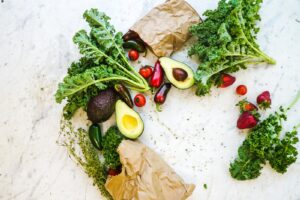As a child I am not sure that I realized you could purchase fresh tomatoes in a store, because all the ones I ate were homegrown and garden-fresh.
My family lived with my grandmother from the time I was six, and every year she grew the most delicious tomatoes. She did not have a huge garden, but instead, she planted tomatoes (and sometimes other vegetables) in the spaces between her beloved rosebushes. I remember that she saved our coffee grounds to amend the soil. Even though the concept of organic gardening was not well known in the 1970s, she instinctively knew that the flavor of the tomatoes would be enhanced by improving the soil. Nano kept gardening well into her 90s, and I still remember the taste of those sweet and juicy tomatoes.
For most of my adult life I have not had a garden, but I still love garden-fresh tomatoes. You can’t buy these in the grocery store because commercial tomatoes have to be picked a bit green to be shipped without bruising. They are then exposed to ethylene gas to turn them red. Yuck!
The most flavorful tomatoes are homegrown or purchased at a farmers market.
It is important to know that conventional tomatoes are number 10 on the Environmental Working Group’s Dirty Dozen list (EWG.org/foodnews/dirty-dozen.php). This means that you should purchase organic tomatoes in order to reduce your exposure to toxins. Since store bought tomatoes, even organic ones, don’t taste great, this is one food you definitely should obtain from a trusted source such as your local farmers market.
While most vendors at local farmers markets are honest, there are always a few who misrepresent conventional produce for organic, so make sure and check out each vendor.
Tomatoes are very nutrient-rich.
They are ranked equal to kale, with a nutrient richness of 34, by George Mateljan (WHFoods.org) in The World’s Healthiest Foods. And, unlike kale, most people enjoy tomatoes. Tomatoes are actually a fruit by botanical classification, although they are eaten as a vegetable. They are excellent sources of vitamins C, A, K, B1, and B6. They are also good sources of the minerals molybdenum, potassium, manganese, chromium, folate, and copper, as well as a number of the carotenoids including lycopene. Lycopene has been found to protect cells, DNA, and LDL cholesterol from oxidation. But the synergy from the nutrients in tomatoes as a whole are even better than lycopene alone and are protective against cancer and heart disease. Interestingly, many of the nutrients in tomatoes are actually released in greater quantities when tomatoes are cooked rather than eaten raw, so enjoy them both cooked and raw.
Tomatoes also have the best taste when they are stored at room temperature.
You should not refrigerate them unless they are in danger of over-ripening. To avoid additional chemical exposures when buying canned tomatoes, try to purchase them either in glass or in BPA-free cans, because the acidity in tomatoes can cause the chemicals in the linings of the cans to leach out.
Tomatoes are a member of the nightshade family of plants.
This family includes potatoes, chili peppers, green and red peppers, paprika, and eggplant in addition to tomatoes. Nightshade sensitivity is a problem for some people, particularly those with joint problems such as rheumatoid arthritis or osteoarthritis. If you have regular joint or muscle pain, you might want to consider eliminating all nightshade vegetables, including tomatoes, for a period to see whether it helps your condition. Many people are sensitive to some but not all nightshades. I am personally sensitive to most nightshades, but raw tomatoes are fine for me.
Whether you enjoy your tomatoes in salads, as part of a BLT, or in spaghetti sauce, I hope you eat plenty of fresh tomatoes this summer. One of our favorite recipes using tomatoes is below.
Cucumber-Tomato Dill Salad
Salad ingredients:
- 2 cucumbers, peeled and sliced
- 2 regular tomatoes, or 1 pint grape tomatoes, cut up
- 1/2 Vidalia (or other sweet) onion, chopped
Dressing ingredients:
- 1 tsp dried dill
- 2 tbsp coconut vinegar or apple cider vinegar
- 1 tbsp extra-virgin olive oil
- 1/2 tsp sea salt
Combine the cucumbers, tomatoes, and onions in a large bowl. Whisk all the dressing ingredients together in a small bowl. Pour the dressing over the salad and gently toss. Let stand for an hour or two for the flavors to combine before serving if possible.
Makes 4–6 servings.
Recipe adapted from The Whole Life Nutrition Cookbook.






